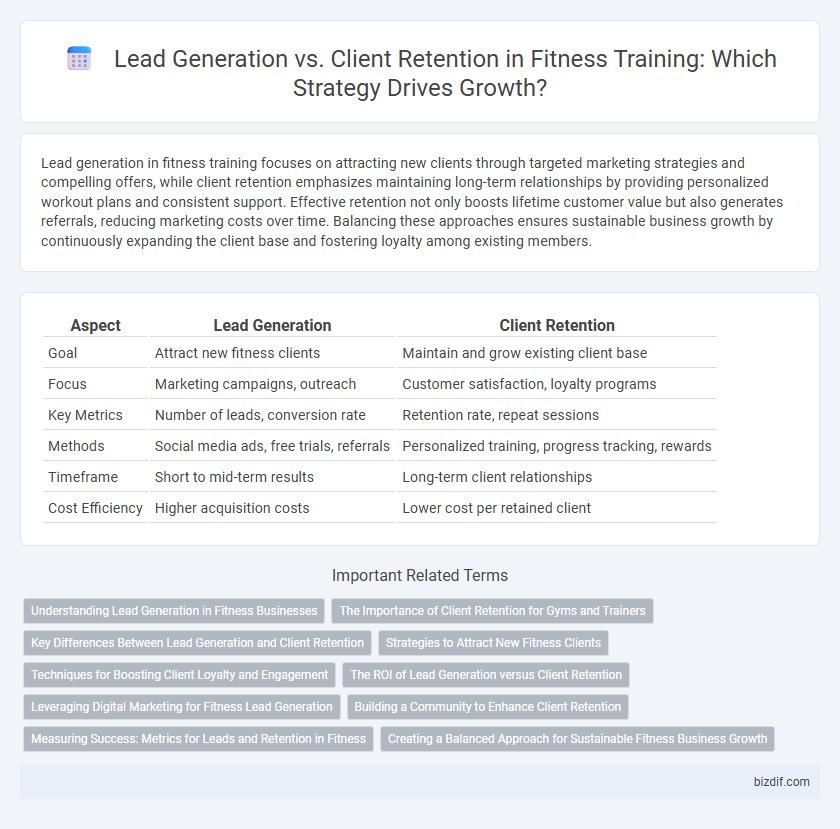Lead generation in fitness training focuses on attracting new clients through targeted marketing strategies and compelling offers, while client retention emphasizes maintaining long-term relationships by providing personalized workout plans and consistent support. Effective retention not only boosts lifetime customer value but also generates referrals, reducing marketing costs over time. Balancing these approaches ensures sustainable business growth by continuously expanding the client base and fostering loyalty among existing members.
Table of Comparison
| Aspect | Lead Generation | Client Retention |
|---|---|---|
| Goal | Attract new fitness clients | Maintain and grow existing client base |
| Focus | Marketing campaigns, outreach | Customer satisfaction, loyalty programs |
| Key Metrics | Number of leads, conversion rate | Retention rate, repeat sessions |
| Methods | Social media ads, free trials, referrals | Personalized training, progress tracking, rewards |
| Timeframe | Short to mid-term results | Long-term client relationships |
| Cost Efficiency | Higher acquisition costs | Lower cost per retained client |
Understanding Lead Generation in Fitness Businesses
Lead generation in fitness businesses involves attracting potential clients through targeted marketing strategies such as social media campaigns, referral programs, and local events to build a robust sales funnel. Capturing high-quality leads requires optimizing online presence with engaging content, clear calls-to-action, and user-friendly booking systems. Effective lead generation increases the client base, which is essential for long-term revenue growth and brand visibility in the competitive fitness industry.
The Importance of Client Retention for Gyms and Trainers
Client retention in fitness training significantly boosts long-term revenue by maintaining a loyal member base, which costs less than acquiring new clients through lead generation. Consistent engagement, personalized workout plans, and community-building strategies enhance client satisfaction and reduce dropout rates. Prioritizing retention improves brand reputation and maximizes lifetime customer value, making it a critical focus for gyms and trainers.
Key Differences Between Lead Generation and Client Retention
Lead generation in fitness training focuses on attracting potential clients through targeted marketing strategies and promotional offers, aiming to increase the number of new sign-ups. Client retention emphasizes maintaining ongoing relationships by providing personalized workout plans, consistent engagement, and exceptional customer service to encourage loyalty and repeat business. Key differences lie in lead generation's priority on expanding the client base, while client retention centers on enhancing client satisfaction and lifetime value.
Strategies to Attract New Fitness Clients
Effective strategies to attract new fitness clients include targeted social media campaigns, offering free trial classes, and leveraging local SEO to boost online visibility. Utilizing referral programs and partnerships with local businesses can expand reach and build credibility. Crafting compelling content that highlights success stories and unique training approaches increases engagement and conversion rates.
Techniques for Boosting Client Loyalty and Engagement
Implement personalized follow-up routines and tailored workout plans to enhance client engagement and satisfaction in fitness training. Leveraging client progress tracking and offering exclusive incentives such as loyalty rewards or referral bonuses significantly boost retention rates. Integrating community-building activities and targeted communication fosters a strong sense of belonging, encouraging long-term commitment to fitness programs.
The ROI of Lead Generation versus Client Retention
Lead generation in fitness training drives new memberships, offering high initial returns by expanding the client base quickly, but often incurs substantial marketing costs per lead. Client retention delivers a higher long-term ROI through consistent revenue from loyal members, reduced churn rates, and lower acquisition expenses. Optimizing fitness business growth requires balancing investment in both robust lead generation campaigns and effective retention strategies to maximize overall profitability.
Leveraging Digital Marketing for Fitness Lead Generation
Leveraging digital marketing for fitness lead generation enables targeted campaigns through social media advertising, SEO optimization, and personalized email marketing, effectively attracting potential clients. Utilizing data analytics and customer behavior insights maximizes ad spend efficiency and improves conversion rates by tailoring offers to specific demographics. Continuous engagement via digital platforms also establishes brand authority and trust, crucial for converting leads into loyal clients.
Building a Community to Enhance Client Retention
Building a strong fitness community fosters deeper connections and increases client retention by creating a supportive environment that motivates consistent engagement. Regular group activities, personalized challenges, and social interaction enhance client loyalty and encourage members to become brand advocates. Prioritizing community-building initiatives leverages social proof and shared goals, leading to sustained membership growth and long-term revenue stability.
Measuring Success: Metrics for Leads and Retention in Fitness
Tracking lead generation success in fitness training involves metrics such as the cost per lead, lead conversion rate, and source attribution to identify the most effective marketing channels. Client retention is measured through retention rate, average client lifetime value, and frequency of repeat sessions, providing insights into ongoing engagement and satisfaction. Combining these metrics enables fitness businesses to optimize marketing strategies and enhance long-term profitability.
Creating a Balanced Approach for Sustainable Fitness Business Growth
Lead generation strategies attract new clients through targeted marketing and referral programs, expanding the client base effectively. Client retention focuses on personalized coaching, consistent communication, and progress tracking to build loyalty and long-term engagement. Combining both approaches ensures sustainable fitness business growth by maintaining steady revenue streams and fostering a strong community.
Lead Generation vs Client Retention Infographic

 bizdif.com
bizdif.com